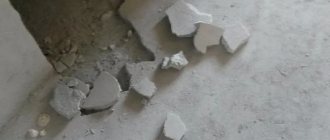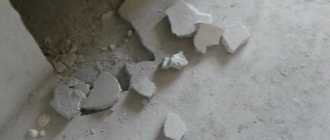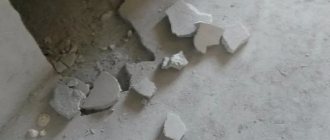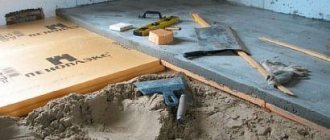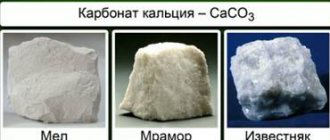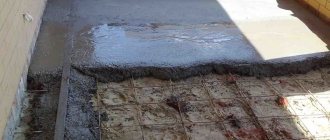Rough finishing is an invisible but very important part of the renovation. The quality of its implementation determines how the final coating will look and how long it will last in its original form. Therefore, before starting finishing work, you need to make sure that the base is strong and reliable, and, if necessary, eliminate defects. If, after leveling, cracks appear in the floor screed, what to do with such a base must be decided on the spot, depending on the scale of the damage, the area of the object, and the type of finished floor covering.
Sometimes it is easier to redo a screed than to repair it Source homemasters.ru
Looking for the cause of the problem
To solve the problem once and for all, you need to find and eliminate the cause of its occurrence, otherwise it will recur. This also applies to situations where the floor screed is cracked - what to do with the cracks can only be decided after you understand why they appeared.
In general, on a surface finished with cement mortar, cracks often form due to the low plasticity of the material and its ability to expand and contract with temperature changes. Their occurrence can be avoided only by strictly following the technology of mixing the solution, preparing the base, installing the screed and fulfilling the conditions necessary for its uniform drying.
The slightest deviation in any of the above points is likely to cause cracking of the cement coating. Most often this happens in the following cases:
- errors when mixing the solution - excess water or uneven distribution of components in the mixture;
Liquid solution has less strength Source strojlyuks.ru
- insufficient screed thickness;
- weak, sagging or vibrating foundation under the screed;
- absence of damper joints or technological gaps between the screed and the walls;
- uneven drying of the solution due to drafts, temperature changes or as a result of forced drying.
The listed factors refer to gross violations of the manufacturing technology of concrete floor screed, which may lead to the impossibility of restoring the coating using spot repairs. If it is covered with deep cracks over the entire area, crumbles underfoot or “breathes,” the screed must be dismantled and remade.
Dismantling a screed is a dirty, time-consuming and expensive job, so it’s better to do everything right right away Source amazonaws.com
If concrete was poured on an unstable sandy base, on a wooden floor or thermal insulation slabs, and the floor screed cracked, what to do: pour another layer on top with mandatory reinforcement with steel mesh.
Defects in a fresh cement coating may not appear immediately, so after finishing the work you need to wait at least 3-4 weeks and then carry out an inspection. To do this, tap the screed with a rubber mallet, revealing local delaminations of the concrete, and strips of thin paper are glued onto the cracks and left for 10-14 days. If after this time it remains intact, it means that the cracks are stable and will not deepen or expand. If the paper is torn, this indicates that the concrete layer is unreliable - it will continue to deteriorate.
Concrete breaks down and crumbles - what to do: main reasons, how to prevent
Nothing is eternal; every building structure deforms over time as a result of mechanical stress and the influence of the natural environment. Concrete is a durable building material that is made from cement and is also susceptible to destruction. Therefore, many private developers are interested in what to do if the concrete begins to crumble.
Natural destruction of concrete.
Making expansion joints
One of the main reasons for cracking of a concrete slab is the lack of compensation gaps around the perimeter of its abutment to vertical barriers - walls, columns, thresholds, etc. And in rooms with a large area, the screed can crack and swell during shrinkage and during linear expansion, if expansion joints are not installed in it, dividing the solid slab into several sections independent from each other.
The expansion joint allows the screed to expand freely Source tb.ru
See also: Catalog of companies that specialize in home insulation
Before repairing cracks in the floor screed, it is necessary to arrange all the necessary technological joints in it, otherwise they will appear again and again. And the sooner you do this, the better.
It will no longer be possible to create gaps between the floor and the wall using a finished screed. But you can cut the grooves as close to the wall as possible using a grinder with a large diameter disk or a wall chaser. If there are columns, a shrinkage seam is made around them, but not parallel to the edges, but in the form of a diamond, so that the corner of the column looks at the straight section of the groove.
If the dimensions of the room on one or both sides exceed 3-4 meters, the seams must be cut across it.
Note! The depth of the groove must be at least a third of the thickness of the screed, and the width must be at least 10 mm.
The finished cracks in the floor are cleaned of debris and primed. After the primer has dried, they are filled with polyurethane sealant or special mastic. After drying, these compositions retain elasticity, which will allow the cut cards to move independently of each other without transferring deforming loads.
Filling the seam with sealant Source stiagka-pola.ru
Concrete grinding
The surface layer of a concrete floor is not very durable, so when it is exposed to mechanical loads, changes in temperature and humidity, it begins to crumble, which leads to a reduction in the life of the floor. In addition, the process of concrete maturation is always accompanied by the release of cement laitance to the surface. When hardened, this milk forms an extremely fragile layer, which often becomes the main source of the formation of cement dust. To prevent dust formation, it is necessary to remove the top weak layer of concrete and expose a stronger surface. To do this, grind the concrete floor.
Sanded floors have a number of positive qualities:
There are different technologies for installing polished concrete pavement, so they can consist of a different number of stages. The number of these stages depends on many factors, including the initial state of the concrete floor, the conditions for this process, and the type of tool used.
In any case, the process includes the following main steps:
Grinding can act as an independent procedure for strengthening a concrete floor or as a preparatory step before applying reinforcing compounds, since it increases the adhesion of the concrete surface to any building mixtures and solutions.
Sanding is used for both freshly laid floors and old substrates.
The first pass on a freshly laid floor is made no earlier than 6-7 days after pouring the concrete mixture. This is necessary in order to remove the layer of cement laitance and open a more durable layer for better ripening. Final grinding is performed no earlier than a month later, that is, after the concrete has fully matured.
Before grinding an old concrete base, its readiness for this procedure is first assessed. “Weak” areas - looseness, peeling, crumbling - are unacceptable. If such defects are present, it is necessary to carry out repair work using epoxy compounds.
More details about repairs with epoxy mastic are described in the article Eliminating defects in a concrete floor using epoxy mastic
If the damage covers more than 30% of the floor area, a new screed is poured.
Other methods of repairing a concrete floor are described in the article Basic methods of repairing a concrete floor
We repair the screed
How to repair cracks in a floor screed depends on the degree of deformation of the subfloor.
Sealing microcracks
Shallow, small cracks usually do not cause problems. They arise due to improper concrete drying conditions. If they begin to appear soon after pouring, the floors should be wetted and covered with film.
Very thin microcracks can be left untouched or covered with liquid cement mortar or tile adhesive. If the width reaches several millimeters, it is better to play it safe and seal such cracks to the full depth.
- The crack is opened by cutting off the concrete on both sides of it with a grinder with a diamond blade, which is set at an angle to the crack.
If the amount of work is small, you can get by with a chisel and a hammer Source wp.com
- Pieces of concrete and cement dust are removed from the resulting triangular furrow.
- Its walls are well impregnated with a deep penetration primer.
- After the primer has dried, fill the recesses with the solution, applying it with a small slide.
- As soon as the solution sets, but does not completely harden, the excess is removed from the surface with a spatula.
If you immediately level the repair mixture over the surface, then during the drying process it will shrink and a depression will form.
How to repair?
As soon as you have diagnosed the existing detachments, and also if the screed is swollen, you must begin repair work.
However, we note that repairs can only be done if the surface does not exceed 30% of the total area of the self-leveling floor. Delaminations can be repaired in the following ways.
Carrying out pinpoint injections using a liquid repair mixture
First, you will need to use tapping to find problem areas and mark them with chalk. And then in the area of delamination, make channels with a diameter of 15-20 mm.
Do not forget that the distance between the holes should not exceed 30 cm. Then remove dirt and dust from the channels, and only then fill in the primer mixture. Try to moisten the entire inner surface evenly.
As soon as you finish pouring, dry the surface with a special hair dryer. Do everything slowly, you need the solution to be evenly distributed over the entire surface.
Carry out the procedure until the channels on top are filled with the mixture. Give the screed about a day so that it can dry thoroughly, and then begin priming and further installation of the finishing surface.
The next option for repairing a damaged screed is to dismantle the damaged area
You will need to clean the problem area from dirt and dust, prime the entire surface and fill it with concrete.
This method is relevant if spot repairs are impossible or the problem area is too large.
Video description
How to strengthen concrete that is peeling off from the base is described in the video:
Having found out why the floor screed cracked and what to do, you can begin repairs.
- First, by tapping, areas of delamination and voids are identified and marked with chalk.
- In the marked places, holes are drilled in the screed at a distance of 15-20 cm from each other.
- After cleaning and priming, an epoxy mixture is poured into the holes.
- It also seals cracks.
- After the mixture hardens, the holes are filled with liquid cement mortar.
It is important! This method cannot be used if a water or electric heated floor system is installed in the screed, or other communications without an accurate wiring diagram.
When drilling repair holes, there is a high risk of damaging the cable Source sense-life.com
What to do if concrete cracks
If cracking of concrete structures is detected, it is recommended to immediately repair the cracks. But first, the circumstances surrounding the occurrence of these destructions are clarified.
Priming of concrete after restoration.
If water gets into the concrete, the following measures must be taken:
To repair large cracks, it is recommended to use building mixtures that are specifically designed for such repair work. If you need to repair microcracks, you can mix the cement-sand mortar yourself.
In case of major destruction of the load-bearing concrete structure, it is dismantled and re-filled. Concreting can be done in parts, but must be reinforced. It is recommended to trust professional builders to carry out repairs in case of major damage to structures.
Is crack repair always necessary?
Even experienced craftsmen cannot always guarantee that the cement screed will retain its solidity and integrity, since, despite its hardness and strength, it is a fragile material that is completely unable to adapt to environmental changes and withstand excessive loads.
In addition, having an impressive weight, the poured concrete slab under the final coating will not go anywhere, even if it cracks. It is not necessary to repair it if:
- the cracks are small and rare, not prone to expansion;
- when tapping with a mallet or walking along the edges of cracks, dust does not rise from them;
- the base does not vibrate under the weight of a walking person;
- Laminate, linoleum or other covering will be laid on the screed without rigid adhesion to it.
But in the case of finishing the floor with ceramic tiles, the diverging edges of the cracks can transfer stress to the tile adhesive and to the tile itself, hopelessly ruining the expensive coating.
A weak screed is the reason for cracking of tiles Source agromat.ua
So that there are no cracks
If you think in advance about how to make a screed so that it does not crack, you can avoid the hassle of repairing it. To do this, several conditions must be met.
- The thickness of the screed at its thinnest point should be at least 20 mm, and if the base is sand, expanded clay or insulation boards - at least 30 mm.
- When installed on a weak or shrinkage-prone base, the screed must be reinforced.
- The screed must be poured over the entire area at once, without taking long breaks.
- If this is not possible, arrange expansion joints at the junction of the dried and fresh mortar.
- Observe the proportions exactly when mixing the solution, taking into account the brand of cement and the moisture content of the sand.
- If, after leveling, puddles of water form on the surface, it means there is too much of it in the solution; it is better to immediately redo this area.
- Avoid drafts during the first days of drying the solution.
- As soon as the screed sets, cover it with film.
- If the air in the room is dry and hot, periodically moisten the surface with water so that the concrete dries evenly.
What to do, how to prevent
It is recommended to take protective measures immediately after detecting signs of deformation of the base. If this is not done, the damage will be much greater, and accordingly, repairs will cost more.
The first signs of concrete destruction:
The detected causes of deformation are instantly eliminated. The foundation is protected from flooding and insulated. If the base is severely damaged, you need to make a casting with reinforcement. Special restoration patches are used to seal small cracks.
In order to prevent premature destruction of the garage floor and the foundation of buildings, it is recommended to constantly carry out their prevention.
Briefly about the main thing
Cracks in screeds are a frequent and poorly controlled phenomenon. They are formed even with strict adherence to the work technique due to uneven shrinkage of the material, which does not have plasticity. They don't always require repairs. But if the defects occupy a large part of the surface and tend to grow and increase, and the floor “breathes” underfoot, the cracks must be sealed using cement mortar, tile adhesive, sealants or epoxy resin, depending on the situation. It is also advisable to fasten the largest crevices with metal brackets in the transverse cuts.
